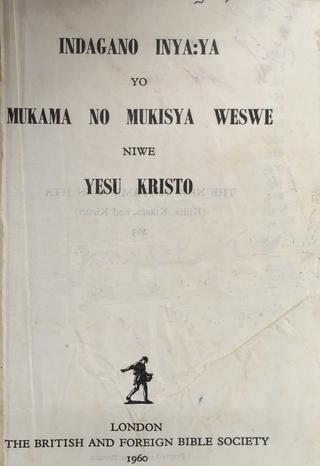Related Research Articles
Central Kilimanjaro, or Central Chaga, is a Bantu language of Tanzania spoken by the Chaga people.
Myene is a cluster of closely related Bantu varieties spoken in Gabon by about 46,000 people. It is perhaps the most divergent of the Narrow Bantu languages, though Nurse & Philippson (2003) place it in with the Tsogo languages (B.30). The more distinctive varieties are Mpongwe (Pongoué), Galwa (Galloa), and Nkomi.
Kwangali, or RuKwangali, is a Bantu language spoken by 85,000 people along the Kavango River in Namibia, where it is a national language, and in Angola. It is one of several Bantu languages of the Kavango which have click consonants; these are the dental clicks c and gc, along with prenasalization and aspiration.
The Teke languages are a group of Bantu languages spoken by the Teke people in the western Congo and in Gabon. They are coded Zone B.70 in Guthrie's classification. According to Nurse & Philippson (2003), the Teke languages apart from West Teke form a valid node with Tende :
Bushong is a Bantu language of the Kasai Province of Democratic Republic of the Congo. It was the language of the Kuba Kingdom.

Jita is a Bantu language of Tanzania, spoken on the southeastern shore of Lake Victoria/Nyanza and on the island of Ukerewe.
The Nzebi languages are a series of Bantu languages spoken in the western Congo and in Gabon. They are coded Zone B.50 in Guthrie's classification. According to Nurse & Philippson (2003), the Nzebi languages form a valid node with West Teke (B.70). The languages are:
The Tsogo languages are a clade of Bantu languages coded Zone B.30 in Guthrie's classification. According to Nurse & Philippson (2003), the languages form a valid node. They are:
The Boma–Dzing languages are a clade of Bantu languages coded Zone B.80 in Guthrie's classification. According to Nurse & Philippson (2003), some of Guthrie's B.80 are related to the Teke languages (B.70), and some Yansi varieties belong with the Yaka languages (H.30), but the rest form a valid node. They are:
The Ngondi–Ngiri languages are a clade of Bantu languages. The Ngondi languages are coded Zone C.10 (Ngondi) in Guthrie's classification. According to Nurse & Philippson (2003), they form a valid node with the Ngiri language(s) of C.30:
The Mboshi languages are a clade of Bantu languages coded Zone C.20 in Guthrie's classification. According to Nurse & Philippson (2003), apart from Kyba (Kuba), the languages form a valid node. They are:
The Soko or Soko–Kele languages are a clade of Bantu languages coded Zone C.50–60 in Guthrie's classification. According to Nurse & Philippson (2003), apart from Mongo (Nkundo), the languages form a valid node. They are:
The Bushoong languages are a clade of Bantu languages coded Zone C.80 in Guthrie's classification. According to Nurse & Philippson (2003), apart from Dengese and the Shuwa "dialect" of Bushoong, the languages form a valid node. They are:
- Hendo (Songomeno)
- Bushoong
- Lele
- Wongo
Tongwe (Sitongwe) and Bende (Sibende) constitute a clade of Bantu languages coded Zone F.10 in Guthrie's classification. According to Nurse & Philippson (2003), they form a valid node. Indeed, at 90% lexical similarity they may be dialects of a single language.
Kuba is a Bantu language of Kasai, Democratic Republic of Congo.
The Buja–Ngombe languages are a group of Bantu languages reported to be a valid clade by Nurse & Philippson (2003). They are Buja (C.37), the Ngombe languages (C.41), and Tembo (C.46):
The Bati–Angba or Bwa languages are a clade of Bantu languages, about half of Zone C.40 in Guthrie's classification. According to Nurse & Philippson (2003), these languages form a valid node. They are:
Teke–Mbere is a proposed intermediate group of Bantu languages, coded Zone B.50–80 in Guthrie's classification, along with the erstwhile Mbundu language Songo. According to Nurse & Philippson (2003), they are:
Bango, is a Bantu language spoken in the Democratic Republic of Congo. Ethnologue suggests it may be a dialect of Budza, but Nurse & Philippson (2003) list it as one of the Bwa languages.
Suku is a Bantu language of the Democratic Republic of the Congo.
References
- Nurse, Derek; Philippson, Gérard, eds. (2003). The Bantu languages. London: Routledge. ISBN 9780700711345.